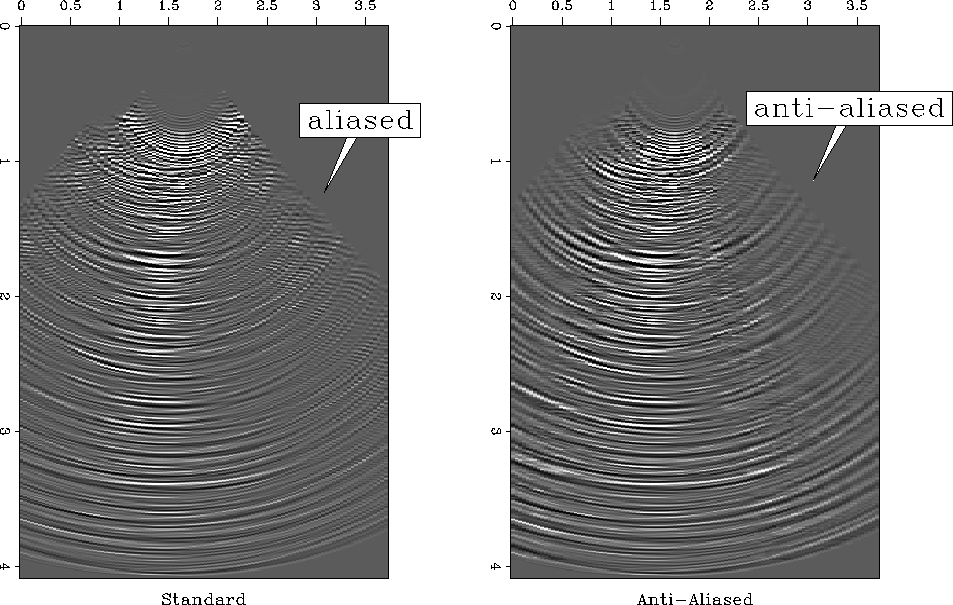




Next: 3-D Migrations
Up: DATA EXAMPLE
Previous: Seismic data
Figure ![[*]](http://sepwww.stanford.edu/latex2html/cross_ref_motif.gif) shows the effective migration operator
``impulse responses'' to standard and anti-aliased
migrations. The responses are the result of migrating
10 adjacent traces with the two different methods to examine the effects of
migration operator spatial aliasing. The ``standard'' response incorporates
the effect of a
shows the effective migration operator
``impulse responses'' to standard and anti-aliased
migrations. The responses are the result of migrating
10 adjacent traces with the two different methods to examine the effects of
migration operator spatial aliasing. The ``standard'' response incorporates
the effect of a  obliquity dip filter and a 45 degree migration
aperture weighting to partially combat spatial aliasing.
This eliminates near-vertical steep dip
aliasing, but leaves a fair amount of spatially aliased speckling within
the aperture cone. The ``anti-aliased'' response combines the standard
response with the local lowpass anti-aliasing triangle filtering, including
the inverse triangle height weighting.
Note that most of the aliasing has been suppressed, resulting in
smooth and coherent migration ellipses. At steep dips the anti-aliased
operator is of lower frequency in comparison to the standard response,
as anticipated, but of similar bandwidth near the horizontal (zero-dip)
portions of the operator.
obliquity dip filter and a 45 degree migration
aperture weighting to partially combat spatial aliasing.
This eliminates near-vertical steep dip
aliasing, but leaves a fair amount of spatially aliased speckling within
the aperture cone. The ``anti-aliased'' response combines the standard
response with the local lowpass anti-aliasing triangle filtering, including
the inverse triangle height weighting.
Note that most of the aliasing has been suppressed, resulting in
smooth and coherent migration ellipses. At steep dips the anti-aliased
operator is of lower frequency in comparison to the standard response,
as anticipated, but of similar bandwidth near the horizontal (zero-dip)
portions of the operator.
responses-ann
Figure 4 Effective migration
operator ``impulse responses'' to standard, and anti-aliased
migrations. The ``standard'' response has a  dip filter and a 45 degree aperture weighting cone.
The anti-aliased response is identical to the
standard response except that it also has the anti-aliasing triangle
filters applied.
dip filter and a 45 degree aperture weighting cone.
The anti-aliased response is identical to the
standard response except that it also has the anti-aliasing triangle
filters applied.










Next: 3-D Migrations
Up: DATA EXAMPLE
Previous: Seismic data
Stanford Exploration Project
11/17/1997
![[*]](http://sepwww.stanford.edu/latex2html/cross_ref_motif.gif) shows the effective migration operator
``impulse responses'' to standard and anti-aliased
migrations. The responses are the result of migrating
10 adjacent traces with the two different methods to examine the effects of
migration operator spatial aliasing. The ``standard'' response incorporates
the effect of a
shows the effective migration operator
``impulse responses'' to standard and anti-aliased
migrations. The responses are the result of migrating
10 adjacent traces with the two different methods to examine the effects of
migration operator spatial aliasing. The ``standard'' response incorporates
the effect of a 